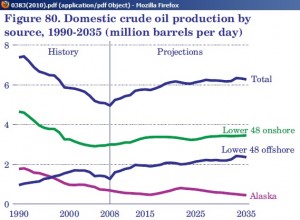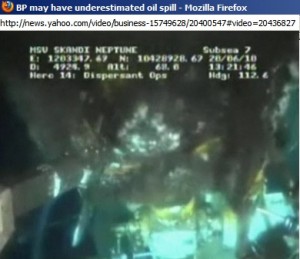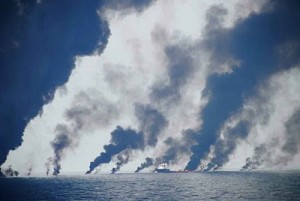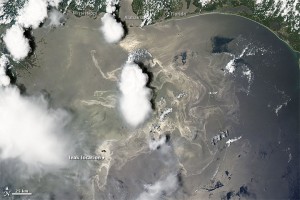This post is updated from time to time
The following graph from Energyfiles shown by Matthew Simmons in a 2007 slide presentation explains the desperate fight for oil after the US peak in 1970
http://www.simmonsco-intl.com/files/UCSB.pdf
1970 US peak oil, together with 1st peak from shallow water
1971 Convertability of US dollar to gold discontinued. Increasing quantities of oil are imported, using US dollars
1973 and 1979 1st and 2nd oil crisis; problems with recycling of petro dollars
1980 Alaska oil is used to offset decline in lower 52, but peaks in mid 80s. Decline continues
1995 Deepwater oil starts to replace declining shallow-water oil, peaks in 2002
1999 North Sea oil peaks
2005 US oil imports limited by peaking of global oil production; game over; subprime mortgage crisis in oil dependent suburbia triggers global financial crisis
This graph shows shallow/deep water oil production with data from Appendix B of the 2008 Interim Report of the Minerals Management Service (http://www.gomr.mms.gov/PDFs/2009/2009-016.pdf)
 These are the maximum flow rates of shallow/deep water oil from the same report (page 53)
These are the maximum flow rates of shallow/deep water oil from the same report (page 53)
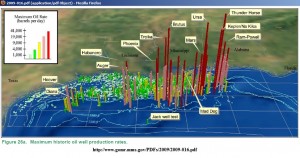 And the MMS projection up to 2018 (which is now doubtful)
And the MMS projection up to 2018 (which is now doubtful)
http://www.gomr.mms.gov/PDFs/2009/2009-012.pdf
Then also these projections from the EIA Annual Energy Outlook 2010 (up to 2035!) for the US offshore are unrealistic:
http://www.eia.doe.gov/oiaf/aeo/pdf/0383%282010%29.pdf
As an example, a good article on the rapid decline in BP’s new Thunder Horse oil field can be found here:
http://www.theoildrum.com/node/6415
Theoildrum is the best site to follow up on what is happening in the Gulf of Mexico, including graphs and videos:
Left: oil coming from riser (30/5/2010)
Right: leaks from under the Lower Marine Riser Package (4/6/2010)
The worst case scenario (13/6/2010)
“….The well bore structure is compromised down hole…..I am convinced the erosion and compromising of the entire system is accelerating and attacking more key structural areas of the well, the blow out preventer and surrounding strata holding it all up and together. This is evidenced by the tilt of the blow out preventer and the erosion which has exposed the well head connection.”
http://www.theoildrum.com/node/6593#comment-648967
The above article contains a link to this site: “How to drill a deep water oil well”
http://www.treesfullofmoney.com/?p=1610
BP may have underestimated oil spill (20/6/2010)
http://news.yahoo.com/video/business-15749628/20436827
Platts: 900 kb/d less from offshore by 2015
http://news.yahoo.com/video/business-15749628/20400547
Markey: Internal BP Document Shows Worst Case Scenario for Spill Could Be 100,000 Barrels Per Day
http://globalwarming.house.gov/mediacenter/pressreleases_2008?id=0272#main_content
23/6/2010 Encyclopedia of Earth: Deepwater Horizon oil spill
http://www.eoearth.org/article/Deepwater_Horizon_oil_spill
The BOP is no longer vertical (28/6/2010)
http://www.youtube.com/watch?v=9bWfI36pFec
Department of Energy: Segments of Oil Well Casing Were Violently Ejected Upwards Into the Blowout Preventer
30/6/2010
The discovery suggested that the force of the erupting petroleum from BP’s well on April 20 was so violent that it sent pipe segments hurtling into the blowout preventer, like derailing freight cars.
http://www.washingtonsblog.com/2010/06/secretary-of-energy-steven-chu-confirms.html
BP Discussing a Backup Strategy to Contain Oil
28/6/2010
Since shortly after oil began spewing into the Gulf of Mexico two months ago, relief wells have been discussed as the ultimate solution, their success in permanently plugging the runaway well deemed a foregone conclusion.
But BP and government officials are now talking about a long-term containment plan to pump the oil to an existing platform should the relief well effort fail. While such a failure is considered highly unlikely, the contingency plan is the latest sign that with this most vexing of engineering challenges — snuffing a gusher 5,000 feet down in the gulf — nothing is a sure thing.
http://www.nytimes.com/2010/06/29/us/29wells.html
MODIS Rapid Response system
Oil in the Gulf of Mexico Project Page
http://rapidfire.sci.gsfc.nasa.gov/subsets/?project=gulfofmexico
Oil Slick in the Gulf of Mexico
http://earthobservatory.nasa.gov/IOTD/view.php?id=44375&src=eoa-iotd
Western Australia’s battle for offshore oil
http://www.crudeoilpeak.com/?p=1425
Is Australia learning the lessons?
Talk of pressure to halt drilling puts wind up industry
THE Rudd government is not about to follow Barack Obama’s lead and slap a six-month ban on the drilling of oil and gas wells while the cause of BP’s Gulf of Mexico oil blowout disaster is determined.
“Shutting down the industry and putting the nation’s energy security, jobs and the economy at risk does nothing towards achieving any of these goals.”
MARTIN FERGUSON (29/6/2010): At the moment it can only get worse because we’re more and more required to import further petroleum products from overseas. And that’s why the last thing we should do is just suspend production or exploration in Australia. Our responsibility is to actually ensure we meet our domestic requirements as best we can.
http://www.abc.net.au/7.30/content/2010/s2940420.htm
An easy step towards energy security would be NOT to build oil consuming infrastructure like the Hunter Freeway
1/3/2010
Hunter Expressway: yet another peak oil ignorant project
http://www.crudeoilpeak.com/?p=1203
and the M2 widening
19/6/2010
M2 widening: Primary Energy Dilemma for cars
http://www.crudeoilpeak.com/?p=1631


